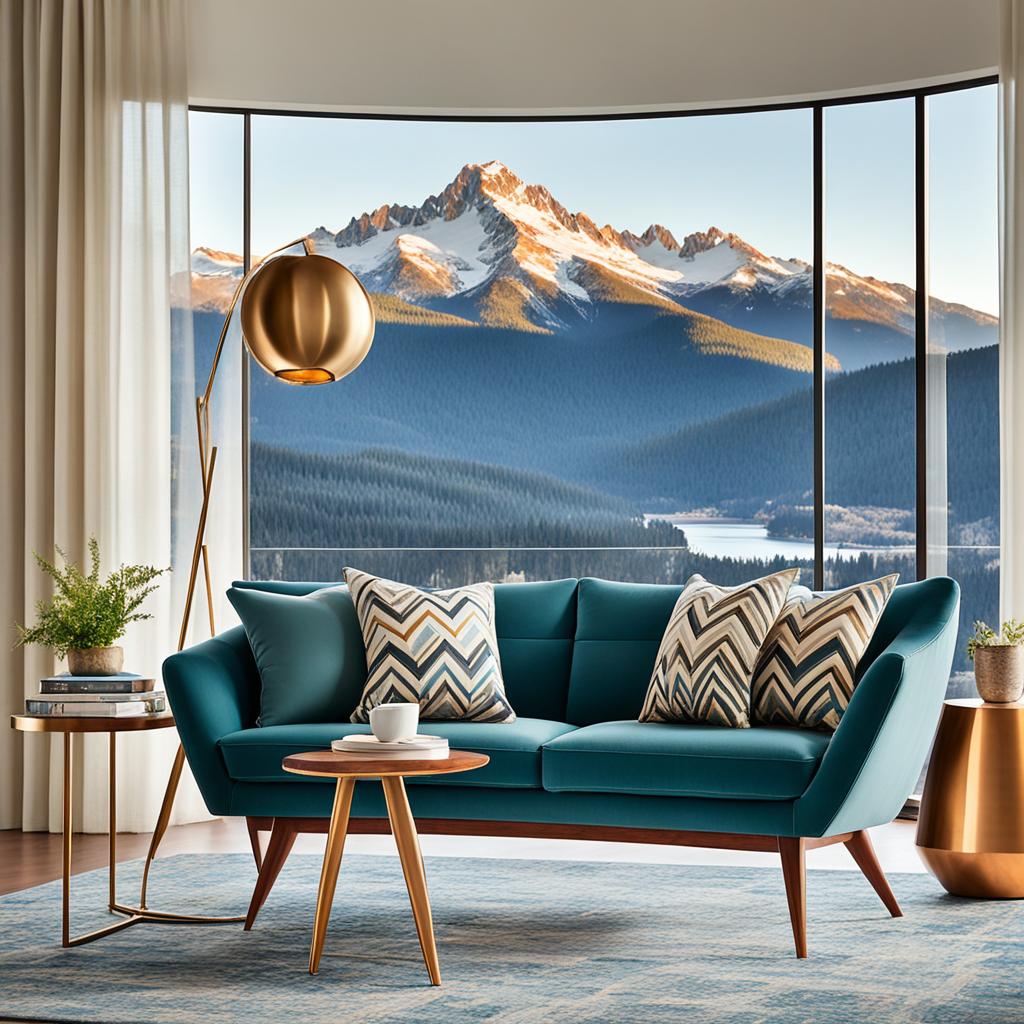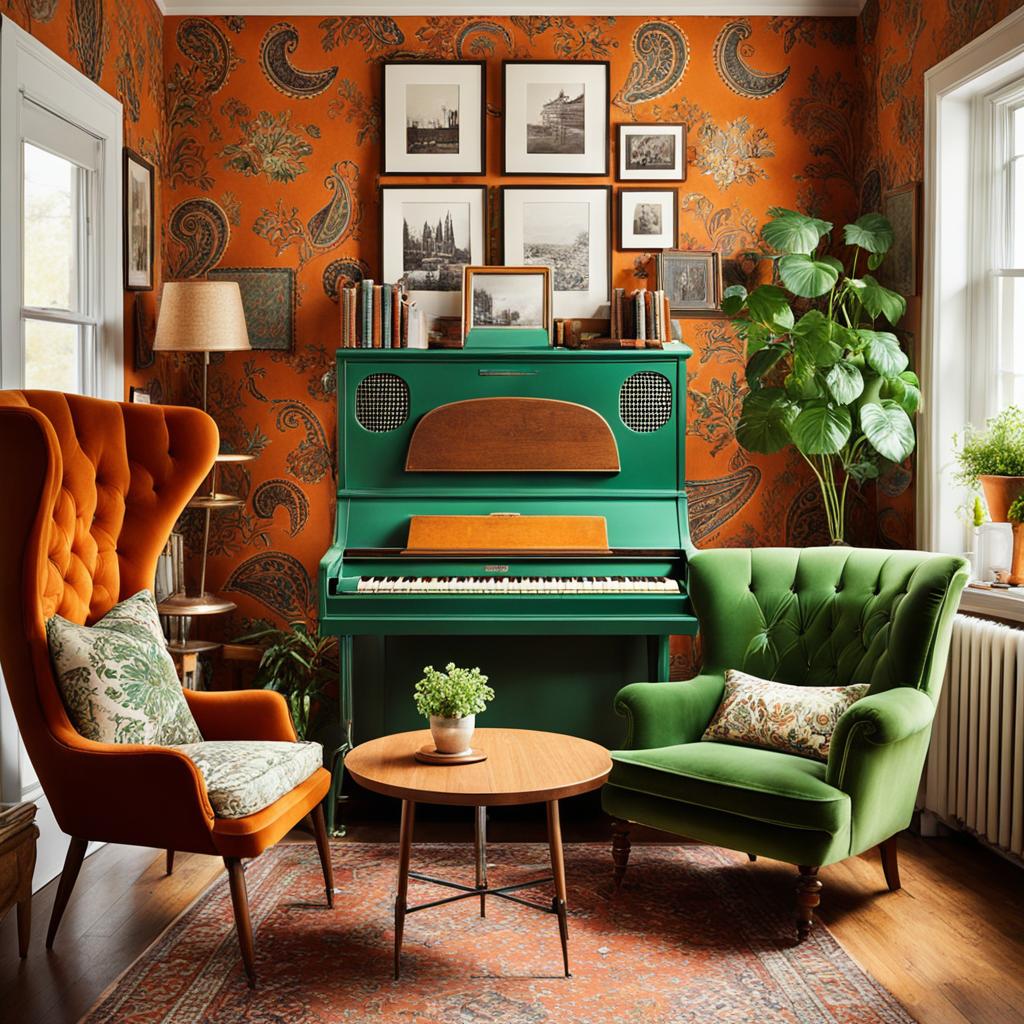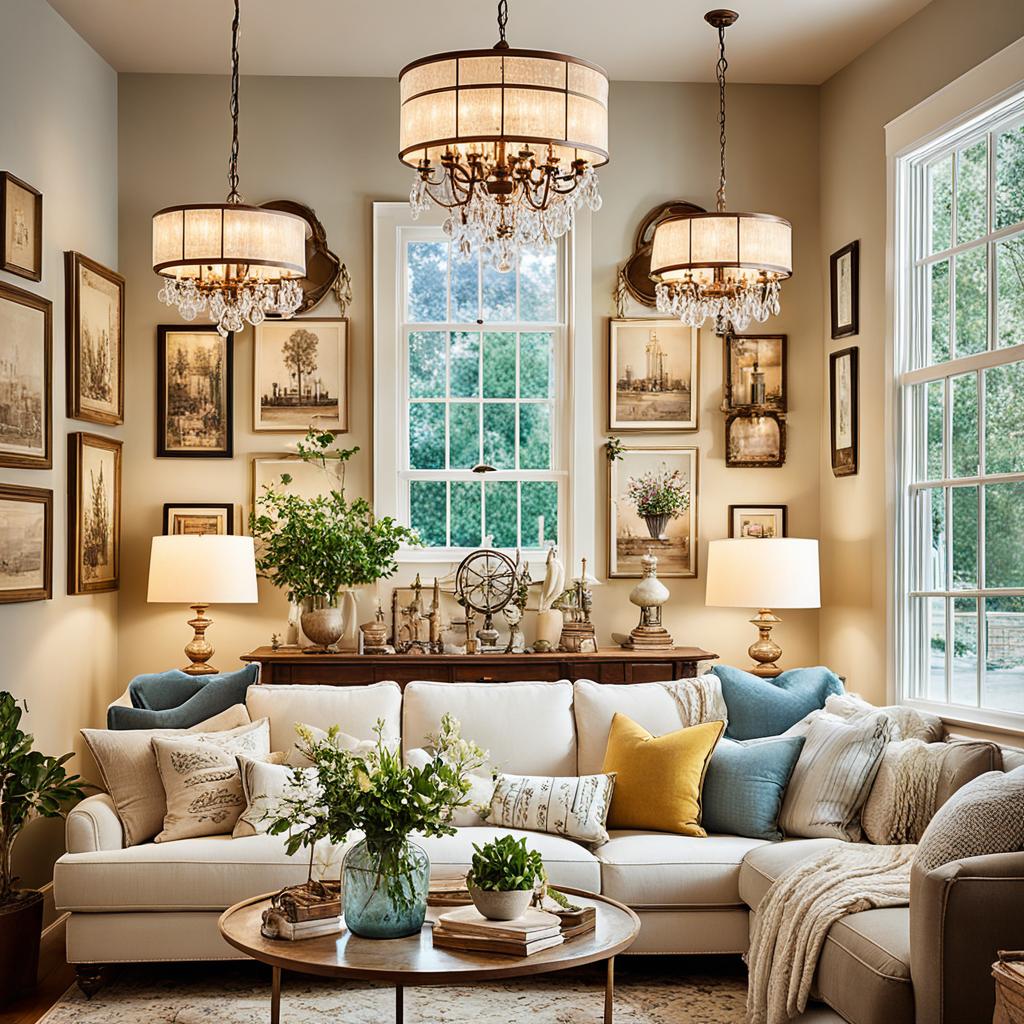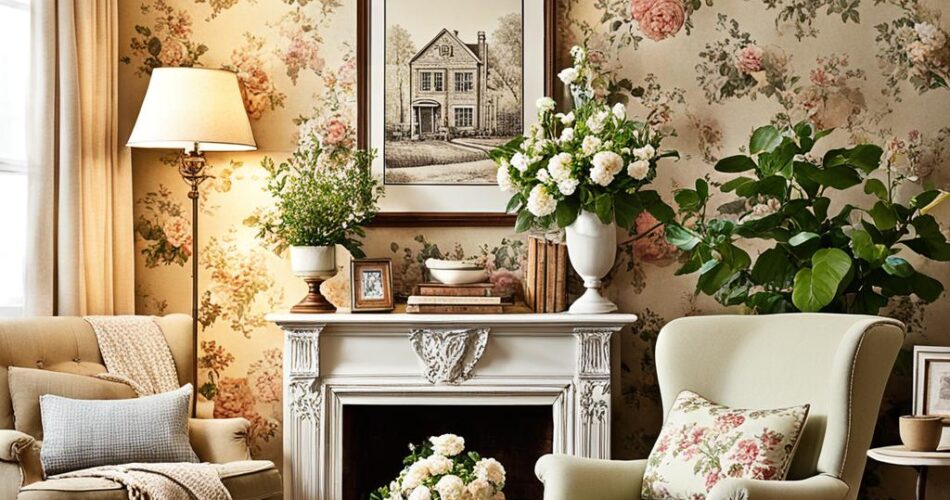Interior design embraces a captivating trend: reviving retro home decor and vintage interior elements. This nostalgic movement celebrates timeless aesthetics, blending past with present to create sophisticated spaces.
It embodies mid-century modern style while infusing contemporary interiors with whimsy and storytelling. Iconic antique furniture pieces, vintage lighting fixtures, and rustic chic design elements are skillfully repurposed.
Designers are upcycling vintage treasures, breathing new life into timeless elements through sustainable practices. Bohemian interior meets modern minimalism, creating nostalgia-inspired interiors evoking emotions and transporting us through time.
Vibrant vintage-inspired color palettes and bold geometric patterns celebrate design elements standing time’s test. This trend invites embracing the past while living in the present.
Key Takeaways
- Retro and vintage aesthetics are making a significant comeback.
- Mid-century modern design attracts a new generation with minimalist aesthetic.
- Designers add character and sophistication through retro elements.
- Vintage colors, textures, and patterns like avocado green are prominent.
- Upcycling vintage pieces aligns with sustainable retro design practices.
- Vintage and modern blend evokes emotions and storytelling qualities.
- Bold colors and patterns like mustard yellow are part of revival.
The Resurgence of Vintage Aesthetics
In recent years, vintage and retro aesthetics have seen a remarkable renaissance. Nostalgia aesthetics and mid-century modern designs captivate homeowners and interior enthusiasts alike. This resurgence showcases the enduring appeal of timeless styles seamlessly blending with contemporary sensibilities.
Timeless Allure of Retro Design
Designers and homeowners infuse modern interiors with nostalgia, creating spaces exuding timeless charm. Seamlessly incorporating repurposed elements and patina finishes into contemporary settings allows a captivating, unique aesthetic celebrating the past while embracing the present.
Blending Past and Present in Interior Spaces
This revival’s beauty lies in blending eclectic styles and heirloom pieces with modern elements. The result is a harmonious, visually stunning interior. Statement furniture with retro flair and curated vignettes featuring vintage accents merge eras, creating a cohesive, distinctly personal living space.

Vintage and retro designs’ popularity stems from a desire for authenticity, nostalgia, and connection to craftsmanship. Secondhand markets, vintage shopping apps, and analog products’ resurgence like film cameras show consumers’ draw to vintage items’ unique aspects and rich histories.
| Market Growth | Statistic |
|---|---|
| Secondhand Market Growth | 24% increase in 2022 (Forbes and Quartz Business Media) |
| Clothing Consumption | 60% increase in purchases, but items kept only half as long (Geneva Environmental Network) |
| Vintage Shopping Apps | Significant increase in popularity for apps like Depop, Grailed, Facebook Marketplace, and eBay |
This renewed vintage appreciation celebrates design and reflects changing consumer values. With sustainability and environmental awareness emphasis, repurposing and reusing vintage items aligns with a more conscious approach to interior design.
Embracing Mid-Century Modern
Mid-century modern design emerged in mid-20th century. It’s making a comeback. Clean lines and iconic retro furnishings blend seamlessly with contemporary interiors, adding nostalgic charm.
Clean Lines and Minimalist Appeal
Mid-century modern emphasizes clean lines and minimalism. This timeless aesthetic appeals to homeowners seeking retro and contemporary styles. These homes feature curved shapes, pops of color, and abundant natural light.
The eclectic blend creates a timeless aesthetic resonating with homeowners. Elements like curved shapes, color bursts, and floor-to-ceiling windows allowing natural light exemplify this ethos.

Iconic Furniture Pieces for a Retro Touch
Incorporating iconic mid-century furniture adds nostalgic retro glamour while keeping a fresh, modern look. Teak sideboards, Eames lounge chairs, and velvet daybeds are prevalent, bringing timeless 1950s aesthetics to present day.
These antique decor pieces in chrome, leather, wood, and velvet authentically capture the era’s retro aesthetics. Materials like these effortlessly blend mid-century charm with modern interiors.
| Furniture Piece | Description | Defining Characteristics |
|---|---|---|
| Eames Lounge Chair | Designed by Charles and Ray Eames in 1956, this iconic chair is a symbol of mid-century modern design. | Molded plywood and leather upholstery, sleek lines, and a contoured shape for comfort. |
| Teak Sideboard | A popular storage solution in mid-century homes, these sideboards were often made of teak wood. | Slimline design with minimal ornamentation, emphasizing wooden textures and slim legs. |
| Velvet Daybed | A versatile piece that can serve as a sofa or a bed, often featuring a tufted velvet upholstery. | Sleek lines, low profile, and a luxurious velvet finish in rich hues like mustard or emerald. |
Mass furniture production from 1950s made stylish mid-century interiors affordable. Platforms like Narchie, Facebook Marketplace, Gumtree, and Freecycle offer vintage and second-hand options. Brands like La Redoute, West Elm, and John Lewis & Partners provide mid-century-inspired pieces.
Incorporating Vintage Elements
Modern spaces embrace the timeless allure of nostalgic styles. Upcycled pieces and repurposed accents breathe new life into vintage finds. The past blends seamlessly with the present, creating eclectic aesthetics.
Upcycling and Repurposing Antiques
Individuals breathe new life into heirloom treasures through upcycling and repurposing. An antique dresser transforms into a charming vanity. A vintage china cabinet becomes a statement piece. These timeless design elements add character and storytelling to modern interiors.
A standout example of vintage incorporation is restoring and showcasing a classic jukebox in a modern living room, transforming the space’s character and adding nostalgic appeal.
Mixing Vintage and Modern Furnishings
Creating a harmonious and captivating space requires the perfect old-new blend. Designers pair vintage pieces with contemporary furnishings for a fresh, relevant feel. Repurposed accents shine as focal points, complementing modern interior elements.

A mid-century modern armchair with a minimalist sofa. An antique mirror adorning a contemporary gallery wall. Mixing vintage and modern elements creates dynamic, visually engaging atmospheres.
| Vintage Element | Modern Pairing | Design Benefit |
|---|---|---|
| Antique oak armoire | Minimalist white walls | Adds warmth and texture |
| Retro patterned rug | Neutral-toned sofa | Introduces bold color and personality |
| Vintage chandelier | Sleek, industrial dining table | Creates a captivating contrast |
By curating vintage and modern furnishings, homeowners create spaces exuding character and contemporary flair. Their unique style embraces nostalgic styles and eclectic aesthetics.
Retro Color Palettes and Textures
Embracing retro design’s nostalgic ambiance involves vibrant color palettes. These distinctive textures transport us back in time. Designers infuse contemporary spaces with eclectic charm. They inject timeless elegance and personality through playful elements.
Bold Hues and Geometric Patterns
Retro design revival incorporates bold, vivid hues. These defined various eras, from 1970s avocado greens to 1980s electric blues. These classic aesthetics find their way into modern interiors. Geometric patterns like polka dots add throwback style and youthful energy.
Psychedelic motifs reminiscent of the 1960s add a sense of youthful energy.

Textured Materials for Added Depth
Incorporating textured materials creates a layered, multidimensional retro aesthetic. Shaggy rugs, macramé hangings, and velvet upholstery add tactile interest. They evoke a sense of heritage design. Combined with colors and patterns, they blend nostalgia and contemporary flair.
| Decade | Color Palette | Defining Elements |
|---|---|---|
| 1950s | Soft pastels, baby blue, mint green, blush pink | Feminine, delicate hues in interior design and fashion |
| 1960s | Psychedelic patterns, vibrant oranges, electric blues, lime greens | Bold, adventurous colors reflecting the spirit of the era |
| 1970s | Earthy tones, rusty oranges, mustard yellows, avocado greens | Natural, warm hues in home decor and fashion |
| 1980s | Neon brights, electric blue, hot pink, lime green, pastel shades | Vibrant, high-contrast colors in both interiors and fashion |
Embracing retro color palettes and textured materials creates eclectic charm. Designers pay homage to the rich design heritage.
Vintage Lighting and Decor Accents
Crafting a nostalgia-inspired look in your home is effortless with vintage lighting and decor accents. These pieces add character and eclectic style.
Repurposed pendant lights from old buildings make striking centerpieces. They lend an upcycled flair to tall-ceilinged rooms like kitchens and hallways. Mid-century brass chandeliers elevate ambiance with retro sophistication.
Vintage wall lights can serve as elegant decor pieces, creating captivating features without additional adornments. Pairing vintage lighting with contemporary elements blends old and new harmoniously.

Curate nostalgia-inspired aesthetics with vintage items like glass bottles, once practical, now decorative vases or storage containers imparting industrial chic.
Repurpose metal ladders as decorative towel racks. Use vintage file sorters to organize dishes or linens. Nesting nooks store towels, dishes, toys, bedding.
| Vintage Item | Repurposed Use |
|---|---|
| Vintage postcards | Framed decor pieces |
| Vintage typewriters | Decorative and storage pieces |
Creative repurposing of vintage fans, candlesticks, telephones, clocks, photographs, and maps infuses spaces with history, storytelling, and eclectic style through functional, decorative accents evoking nostalgia.
Sustainable Design through Upcycling
Embracing retro revival in interior design is about aesthetics and sustainability. Designers incorporate upcycled and repurposed vintage pieces, giving new life to old treasures. This eco-friendly approach aligns with modern sustainability and adds rustic charm through repurposed vintage pieces.
Eco-Friendly Approach to Retro Revival
The retro revival celebrates vintage beauty and reduces waste. By upcycling antique furniture, homeowners create eclectic design blends combining past charm with modern functionality. This approach reduces environmental impact and personalizes spaces.

Repurposed Vintage Pieces with Character
Repurposed vintage pieces have unique allure modern furnishings lack. They carry history and character, making each item a storyteller. Designers embrace classic touches by incorporating antique dressers, refurbished armchairs, and upcycled lighting. These pieces add visual interest and contribute to rustic chic aesthetics celebrating sustainability.
By embracing upcycling, homeowners create beautiful, trendy, and environmentally conscious spaces. The retro revival offers a bohemian vibe celebrating vintage stories while promoting sustainable practices benefiting homes and the planet.
vintage interior design
Vintage interior design makes a comeback. By using upcycled and classic accents, homeowners add timeless charm to spaces.
Mid-century modern design celebrates iconic furnishings. Eames chairs and Danish teak sideboards blend antiqued accents with modern functionality.
To achieve a vintage vibe, embrace bold colors and patterns from the past. Think mustard yellows, geometric shapes, and polka dots.
Textured materials like shaggy rugs, macramé wall hangings, and velvet upholstery add depth and nostalgia.
Upcycled accents like vintage art, kitschy decor, and retro lighting bring playful, bohemian flair.
- Floral patterns in upholstery, cushions, and fabrics
- Distressed furniture with wooden frames
- Glass chandeliers for a touch of glamour
- Vintage textiles like curtains, pillows, and rugs
| Vintage Style | Key Features | Color Palette |
|---|---|---|
| Victorian | Opulent, dark woods, elaborate furniture | Rich jewel tones, deep reds, greens |
| Art Nouveau | Vibrant, organic shapes, floral motifs | Warm tones like peach, gold |
| Art Deco | Geometric shapes, gold tones, rigid lines | Bold colors, metallic accents |
| Mid-Century Modern | Clean lines, minimalist, space-age aesthetic | Earthy tones, pops of color |
Blending classic patterns with contemporary flair evokes emotions and transports homeowners through time.
Nostalgic Focal Points
Bringing a vintage-inspired look to your home interior can be simple. Designate a nostalgic focal point with retro flair. This statement piece becomes the centerpiece, transporting you to a bygone era.
Consider a mid-century bar cart with art deco influences. Or a vintage record player. Or a bold, vintage-inspired textile accent wall. These create a captivating nostalgic home style.
Statement Pieces with Retro Flair
Incorporating a statement piece is key to achieving a retro revival look. Repurposed pieces like an antique typewriter or refurbished jukebox add character and nostalgia.
For the dining area, consider a retro-styled dinette set. Vibrant colors and playful mid-20th century patterns create the look.
Creating a Vintage-Inspired Vignette
To embrace the eclectic home aesthetic, curate a vignette blending vintage and modern. Start with a statement piece like a tufted velvet sofa or brass and glass coffee table.
Layer in retro accents like a macramé wall hanging, shag rug, and antique books. This thoughtful mix of eras adds depth and personality, showcasing nostalgic design appreciation.
| Vintage Element | Modern Counterpart | Blend Ratio |
|---|---|---|
| Mid-century modern furniture | Contemporary artwork | 60% vintage, 40% modern |
| Retro wallpaper | Minimalist decor accents | 70% vintage, 30% modern |
| Antique light fixtures | Sleek, industrial furnishings | 50% vintage, 50% modern |
Blending vintage and modern thoughtfully creates a timeless, on-trend space. It reflects your style while paying homage to nostalgic charm.
Blending Eras and Styles
Creating a harmonious blend of different styles is key to nostalgic interior design. It balances the old and new, classic and contemporary. By mixing period-inspired interiors, your spaces exude timeless charm with rustic elegance and modern flair.
Curating a Harmonious Mix
For blending eras and styles, careful curation is crucial. Start with classic interior accents you love, like a vintage armchair or antique mirror. Then, pair these with contemporary furnishings, creating interplay among textures, colors, and shapes.
This mix allows vintage elements’ character to shine, while modern pieces provide a fresh counterpoint. The result is a lived-in, personality-filled space that feels refreshingly current.
Finding Balance in Retro Revival
Incorporating nostalgic styling successfully lies in finding balance. Avoid overdoing vintage pieces, making the space feel cluttered or stuck in the past. Follow the 80-20 rule: let 80% be rooted in a contemporary, minimalist base, and 20% carefully curated historical inspiration through vintage accents.
This approach ensures a fresh, modern space paying homage to inspiring design heritage. Blending eras thoughtfully creates a captivating interior celebrating past and present.
| Vintage Element | Modern Counterpart |
|---|---|
| Antique Persian Rug | Minimalist Sofa |
| Mid-Century Modern Armchair | Sleek Coffee Table |
| Retro Sputnik Chandelier | Contemporary Accent Wall |
The table illustrates how vintage elements seamlessly pair with modern counterparts, creating a harmonious blend celebrating both worlds.
Retro Revival in Modern Architecture
The retro revival trend has found its way into modern architecture. Incorporating vintage elements in new builds adds character and history. Designers are reviving classic details to infuse modern homes with charm.
Incorporating Vintage Elements in New Builds
The fusion of old and new creates a harmonious blend. Vintage-inspired light fixtures add an eclectic touch to new spaces. Incorporating repurposed vintage finds lends a sense of history and character.
Reviving Classic Architectural Details
Architects are reviving classic details that pay homage to historical influences. Eclectic styling blending modern and traditional elements has become popular. Incorporating elements like coffered ceilings, crown moldings, or wainscoting adds elegance.
The revival of mid-century modern design principles, like open floor plans, is a prominent trend. This fusion creates a unique aesthetic celebrating vintage design’s appeal.
| Design Element | Mid-Century Modern | Retro Revival |
|---|---|---|
| Floor Plan | Open concept | Blended open and defined spaces |
| Materials | Wood, glass, steel | Reclaimed wood, exposed brick, vintage accents |
| Architectural Details | Clean lines, floor-to-ceiling windows | Arched doorways, wainscoting, decorative moldings |
| Furniture | Iconic mid-century pieces | Mix of vintage and contemporary antique furniture styling |
Modern architecture celebrates vintage design’s appeal while embracing contemporary construction methods. By incorporating historical influences and eclectic styling, architects create resonating spaces.
Conclusion
The retro revival’s timeless trends sweep contemporary spaces. Vintage elements captivate, evoking emotions and transporting through time. This movement offers homeowners nostalgic yet stylish spaces.
Embracing mid-century modern’s sleek lines or Victorian opulence unveils design elements. Upcycled bohemian accents inject character into modern homes. Repurposed furniture and curated vignettes breathe life into treasures.
Integrating timeless trends with contemporary flair crafts personal, nostalgic spaces. Vintage design connects us to shared histories and legacies. Curating classic elements elevates living spaces, celebrating timeless beauty.
